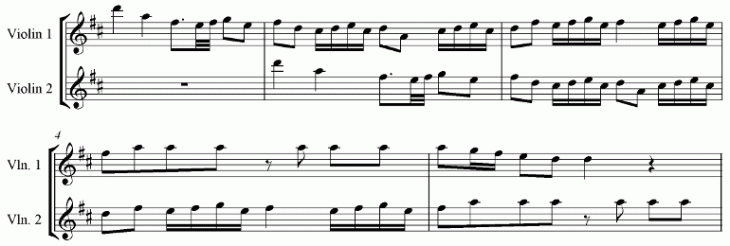- Counterpoint Tutorials -
The Contrapuntal Skeleton - Conclusion
Now that we've delved into the infrastructure of this canon, let's go back to the original score.
Original
Click here to listen!
As we've explored this piece, we've found a few important aspects of the piece that profoundly shape it's form and construction.
This piece is a canon.This alone attributes a great deal to the back bending and rule-breaking Telemann uses. The lack of suspensions and awkwardly approached dissonances are directly caused by the quickly moving lines created by dovetailing voices.
This piece has, generally, a closed contour. Look how close together those parts are! This is caused by the intimacy of parts found in the first species; further species are simply embellishments on the the close contours.
This piece sounds pretty happy. There are a great deal of consecutive thirds and sixths,and few dissonances. There are no dissonances on strong beats. The tempo is upbeat, and there is a moderate ratio of stepwise motion to leaps.
When you write your own counterpoint, take these ideas into consideration. Some things, like tempo, seem very obvious when writing an upbeat, excited piece of music. Other things, like dissonance placement, may not.
This piece is a canon.This alone attributes a great deal to the back bending and rule-breaking Telemann uses. The lack of suspensions and awkwardly approached dissonances are directly caused by the quickly moving lines created by dovetailing voices.
This piece has, generally, a closed contour. Look how close together those parts are! This is caused by the intimacy of parts found in the first species; further species are simply embellishments on the the close contours.
This piece sounds pretty happy. There are a great deal of consecutive thirds and sixths,and few dissonances. There are no dissonances on strong beats. The tempo is upbeat, and there is a moderate ratio of stepwise motion to leaps.
When you write your own counterpoint, take these ideas into consideration. Some things, like tempo, seem very obvious when writing an upbeat, excited piece of music. Other things, like dissonance placement, may not.
So, did Telemann do this species thing when writing his canons?
No, probably not - but Telemann was doubtlessly very much aware of this style, and knew his counterpoint to a formidable degree. Instead of constantly reaching for Fux' textbook, he probably simply internalized the style and wrote by instinct and sensibility. It is no coincidence that there are no similarly approached or hidden perfect intervals in this piece. Species counterpoint is little else but a tool - albeit a very powerful and complex one. How it is used and applied is completely up to the composer.
Further reading and listening
- Take a look at the score here.
- Youtube has exciting performances of Telemann's Canon Sonata No. 3 Mvmt. 1 of various qualities and orchestrations. Click here for an excellent performance of this piece on two harmonica.
- As always, you can consult the original Gradus ad Parnassum (Fux' textbook on counterpoint), available and translated into English on Amazon and other fine online book retailers everywhere. Beware - it's very dry text.

